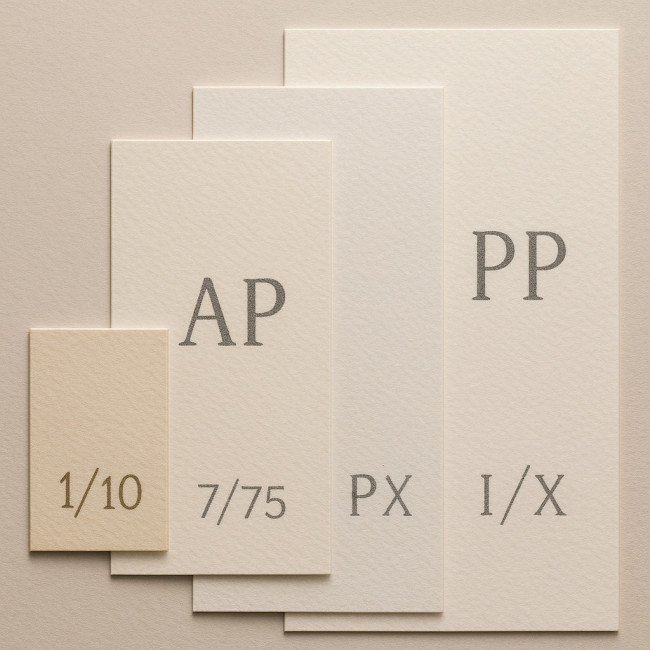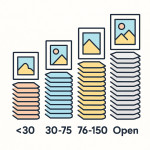Limited-edition numbering rules: guide for printmakers and brand buyers
Confused by 1/50, AP and Roman numerals? This in-depth guide demystifies limited-edition numbering rules so you can print, sell or purchase fine-art multiples with total confidence. You will learn why numbering drives scarcity value, how to avoid legal pitfalls, and which best practices reassure collectors and brand procurement teams.
Why limited-edition numbering matters
Numbering is more than ink on paper. It signals scarcity, authenticity and compliance. A well-documented edition:
- Raises perceived value by up to 300 % compared with open editions.
- Simplifies insurance and secondary-market appraisals.
- Protects both printmakers and corporate buyers from copyright disputes.
Brands searching the expert image-designers directory often shortlist artists based on clear edition data before they even review visuals.
Key limited-edition numbering systems
Standard Arabic edition numbers
The format “7/75” indicates the seventh impression out of a total of 75. Write the fraction in pencil, bottom left-hand margin, before the title and signature. Consistency is crucial to uphold limited-edition numbering rules.
Roman numerals for special subsets
Publishers sometimes reserve “ I/X” to “X/X” for deluxe boxed sets or VIP brand collaborations. These should never exceed 10 % of the main run or you risk diluting scarcity.
Artist's proofs (AP)
Traditionally 10 % of the edition, APs allow colour matching and archive copies. Mark them “AP 3/7”. Do not sell APs at lower prices than the main edition—they often command a premium.
Printer's proofs (PP), Hors Commerce (HC) and BAT
- PP: gratitude prints for the studio; limited to 2–4.
- HC: not for commercial sale; sample use only.
- BAT (“bon à tirer”): the single master signed when colours are approved.
Compliance checklist for printmakers
Follow this step-by-step routine to keep your limited-edition numbering rules watertight:
- Register the edition size in your production log before the first pull.
- Number as you print, not afterwards, to avoid mix-ups.
- Issue a certificate of authenticity (COA) noting edition size, paper, ink and matrix ID.
- Store digital scans of each impression for provenance checks.
- Archive APs separately and mark storage location in your log.
Buying protocol for brands & agencies
Spotting red flags
Use these cues when sourcing prints for campaigns or corporate gifts:
| Red flag | What it means | Action |
|---|---|---|
| Inconsistent handwriting | Possible post-run numbering | Request high-res photos of all signatures |
| No COA | Limited proof of authenticity | Ask for a notarised supplementary COA |
| AP count > 15 % | Artificial scarcity inflation | Negotiate a price reduction or walk away |
Negotiating edition sizes
Brands planning a regional roll-out often need extra impressions. Instead of pushing for a larger run, commission a companion variant with a fresh colourway. Scarcity stays intact and marketing gains exclusivity.
Edition size vs. price impact

Data from the Artnet Price Database (2023) shows a clear correlation between smaller editions and higher average price uplift over open editions. In fact, when the pool of impressions shrinks below fifty, the auction hammer routinely rises by triple-digit percentages, driven by pure supply-and-demand psychology. Collectors see low numbers as a proxy for exclusivity and long-term liquidity; brand buyers like the narrative power of rarity and are willing to pay up to secure talking-point gifts for press or influencers. Conversely, large editions of 250 or more act almost like open editions in the eyes of price trackers and can stall resale momentum. Understanding this dynamic helps both artists and procurement teams set rational edition caps that balance budget with prestige.
Source : Artnet Price Database
Numbering best practices: a live workflow
Before the print run
- Lock edition size in writing with your client.
- Pre-stamp blank margins with a light, erasable code to track sheets.
During printing
- Number each print immediately after it dries.
- Store prints in sequence to avoid accidental duplicates.
- Photograph stacks with visible numbers for your archive.
After release
- Register edition details on blockchain or a COA platform.
- Disclose any damaged pulls and mark them “destroyed”.
- Update resale clauses—see our guide on royalty models.
Case study: brand collaboration with a 3-tiered edition
Luxury fragrance house “Neroli & Co.” needed 600 prints for VIP gifting but wanted to maintain exclusivity. The printmaker proposed:
- Core edition: 200 signed 1-color screenprints (1/200).
- Gold-leaf variant: 50 Roman-numeral prints (I/L) for top influencers.
- Artist's proofs: 20 APs retained for museum loans.
The structure clarified scarcity, boosted perceived value and let the brand upsell framed versions. Logistics were simplified using techniques from our shipping guide for framed prints.
FAQ
- Can I expand an edition after it sells out?
- No. Limited-edition numbering rules are binding. Create a new, clearly different edition instead.
- Is digital numbering acceptable?
- Collectors still prefer hand-pencilled fractions. Digital numbering is acceptable only for purely digital prints accompanied by blockchain COAs.
- How many artist's proofs are ethical?
- Industry standard is ≤ 10 % of the main run. Exceeding that raises red flags with serious buyers.
- Do I need to number promotional prints?
- Yes, mark them HC or PP to prevent confusion with commercial stock.
Test your edition savvy
Ready to master editioning?
Apply these limited-edition numbering rules to your next project or procurement brief. Need deeper guidance? Explore our primer on hiring a printmaker or reach out for bespoke consulting. Start numbering like a pro today!











